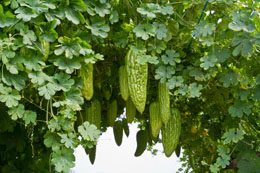A bitter melon is consumed in very limited quantities as it is thoroughly disliked by many, especially children. However, it has numerous health benefits. The following article gives you a gist about how to grow this vegetable.

A bitter melon is found in many nations across Asia. It is also a native to many other nations, which are situated in the tropical belt of the world. Usually, it is often found in the wild, but many farmers cultivate it too.
The intense bitterness of this vegetable gives it the name 'bitter melon'. Some of the other names that are commonly used are balsam pear, bitter gourd, and
Ku Gua. Its scientific or botanical name is
Momordica charantia. This plant is a creeper, and looks very much like a cucumber vine. Its vine is characterized by a curly growth, tendrils, and brilliant flowers that are yellow in color. The bitter gourd itself is a very odd-looking vegetable. It has an oblong shape, and is greenish in color. A very peculiar feature of this fruit is the external skin that is extremely rough and knobbly. This veggie is used to make curry in India. In some of the Indian recipes it is also fried or boiled. Young children especially dislike recipes using this vegetable due to its bitterness.
Method
The process of planting and growing bitter melons is pretty straightforward. It does not require a lot of care as it is adapted to the wild. The following are some of the steps for growing this plant.
- Step 1: The seeds are now available in most of the non-tropical countries. You will need to checkout the nearest nursery or botanical garden in your locality. Another way of acquiring the seeds is by ordering them through the Internet.
- Step 2: The next step is to germinate the seeds. To do that, keep them in water for a time span of about 48 hours. After that the seeds start to swell up. Take off the outer covering of the seed. Be careful while taking it off, and do not damage the seed inside.
- Step 3: Make a small hole in moist soil that is about ¾ inch deep. It is very important to keep the soil moist, till the green shoot of the plant pops out of the ground. This shoot is botanically known as the cotyledon. It takes about a week for it to come on the surface of the soil.
- Step 4: The bitter gourd plant has to be transplanted after about two leaves have appeared on its shoot. The place for transplantation has to be dry and also sunny, as this plant is a victim of fungal diseases. Insert a six feet tall pole in the ground that acts like a support for the creeper. Transplant the bitter melon creeper on a sunny day, when the temperature is about 60°F. It is also very important that the roots and the soil around them are not disturbed while the creeper is being transplanted.
- Step 5: To reap better melons, water the creeper every day, preferably in the mornings. If possible, also place some hay or grass around the base of the creeper, to keep the soil damp. You can also tie the creeper with a delicate cotton or woolen thread to the pole.
- Step 6: In tropical or warm conditions, it appears on the creeper after a time span of about 80 days from the day of transplanting.
Remember, not to be very eager and let the plant take its time to grow out completely.






 A bitter melon is found in many nations across Asia. It is also a native to many other nations, which are situated in the tropical belt of the world. Usually, it is often found in the wild, but many farmers cultivate it too.
A bitter melon is found in many nations across Asia. It is also a native to many other nations, which are situated in the tropical belt of the world. Usually, it is often found in the wild, but many farmers cultivate it too.